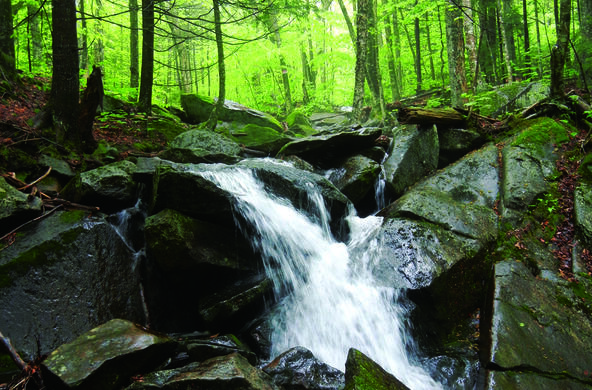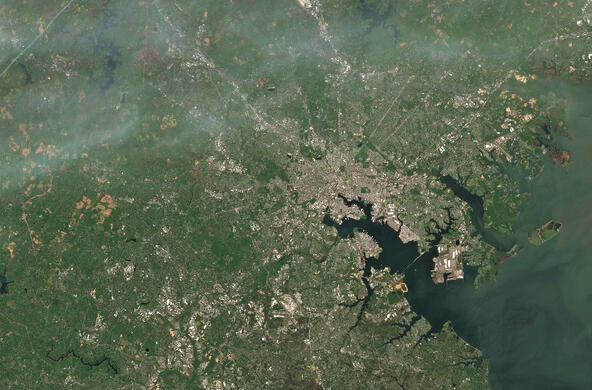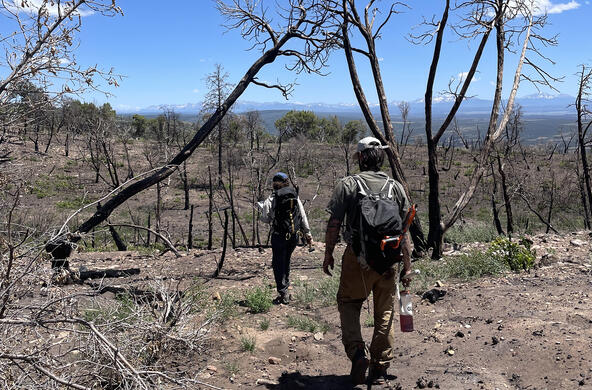One morning in July, nine high school teachers sloshed upstream in the East Branch of Wappinger Creek. As they waded through Cary Institute’s campus in Millbrook, NY, their mission was to look, listen, and observe; to notice similarities and differences as they moved through the cool water and lush greenery.
Along the way, Elizabeth Reeve thought of her students at Bronx Bridges High School, almost all of whom are recent immigrants learning English. “So many of them go through a silent period, where they're just processing everything,” said Reeve. “They don't want to speak, they're just taking it all in. A walk like this would be so nice for them. It's relaxing, and they can just feel their emotions.”
Reeve is one of nine high school teachers participating in the inaugural cohort of Cary’s BIORETS program. (BIORETS stands for Research Experiences for Teachers Sites in Biological Sciences.) Funded by the National Science Foundation, the program provides high school teachers with the opportunity to work with Cary scientists to design and conduct scientific investigations, with the goal of bringing authentic research experiences to their classrooms.
In August, the teachers shared their research findings in a poster session, then presented their plans for reinvigorating their curricula. Now, with support from the program, they’ll begin putting their new lesson plans into action during the upcoming school year.

The educators in this year’s cohort teach in diverse contexts, including schools serving low income families, students with special needs, English-language learners, and incarcerated youth. As a result, each teacher came out of BIORETS with different curriculum ideas based on what works best in their own classroom.
“All the teachers gained a more sophisticated understanding of how to engage students in authentic scientific thinking,” said Cary BIORETS program coordinator Rebecca Van Tassell, “and new ideas of how to support students with diverse learning needs.”
Learning by doing
For six intense weeks this summer, participants immersed themselves in one of three ecological research projects. One group studied how forest canopy gaps affect plant productivity in collaboration with Cary scientists Evan Gora, Ian McGregor, and Vanessa Rubio. Another investigated the effects of native versus introduced plant debris on mosquito egg-laying with Cary disease ecologist Shannon LaDeau. And a third group compared the health of urban soils versus those found in forests or along streams in collaboration with Peter Groffman, a Cary research fellow and professor at CUNY. For many of the teachers, it was the first time they’d ever done anything like this.
“A goal of this new program is to put teachers back in the learner’s seat and let them experience the entire scientific research process, including designing, implementing, and presenting their own research projects, with mentorship from Cary scientists throughout the way,” says program lead Jane Lucas. “Teachers can then take the lessons they learned about global change ecology, and bring them to their classrooms in ways that resonate with a diversity of learners.”
When Steve Hertzog of Arlington High School began the BIORETS program, he was not expecting to have to generate his own research questions, and then figure out how to answer them. Now he wants his students to go through the same process.
Hertzog will assemble two hydroponic gardening systems for his classes to observe and ask questions about. They’ll discuss which questions they could realistically test, and how they might go about it. Then, working in groups, they’ll conduct their own scientific investigations.
“It is tougher than you think,” said Hertzog. “On paper it looks so simple.”

Cary BIORETS revealed to Emily Abma the importance of collecting and using her own data, rather than using generic data from a worksheet. She’ll translate that experience to her students at Meadowbrook Alternative Program by having them construct a food web for the creek that runs through the schoolyard, rather than providing a ready-made one. Her classes will also do nature journaling to hone their observation and question-asking skills.
Embracing the messiness of science
Several of the instructors were struck by the “messiness” of science — the uncertainty, the equipment failures, the data that is hard to understand — as well as the feeling of accomplishment when they come out the other side with greater clarity. They are excited to introduce their students to this aspect of science that isn’t usually mentioned in textbooks, and to let them make their own discoveries.
This upcoming school year, Kelly Czermerys, who teaches science to students with autism at Ulster BOCES, will let her students lead their own research centering on the relationships between human activity and the Hudson River. It will be challenging, said Czermerys, “but having done that myself in this program, that's what I want them to experience…. No matter how messy or chaotic or difficult this may be, I need to bring this back to my students.”
Kickstarting curiosity
“For the first time in a long time, I'm genuinely curious,” said Kristie Wikane, a science teacher at Brookwood Secure Center. Wikane said that, although she never gave much thought to soil before joining BIORETS, she now finds herself constantly asking questions about the data she and her teammates collected, and what it means for urban soils.
“I hope I can bring that curiosity with me back to the classroom and model for my students how to be genuinely curious — to make observations about the world around them, to ask questions, and try to understand,” she said.
Because Wikane works with incarcerated youth, opportunities to perform field research are limited. Instead, her class will use digital storytelling software to discuss human impacts on the planet and share messages of hope, action, and empowerment.

Real experiments, real experiences
Denise Rogers came all the way from Huguenot High in Virginia to attend Cary BIORETS. She plans to replicate her group’s soil experiments with her classes in Richmond. The students will collect soil samples from local parks as well as urban areas of Richmond, and then analyze them for nitrogen, phosphorus, potassium, pH, and soil moisture. “They're going to [put on] some gloves and feel like a scientist,” said Rogers. “And they're going to have a blast.”
The goal will be to better understand the problems Richmond’s soil may face, which communities are most impacted, and what can be done to improve soil quality for underserved communities. “It is my hope that my students will take what we learn and become change agents in their communities to make things better,” said Rogers.

Incorporating new science standards
In 2025, high school students in New York will face entirely new regents exams in biology, earth science, and space science. The new exams will be based on the Next Generation Science Standards, which emphasize real-world science and engineering skills like asking questions, planning and carrying out investigations, and analyzing and interpreting data.
Alan Berkowitz, head of education at Cary and co-leader of the BIORETS program, described the new standards as three-dimensional; they combine core ideas with scientific practices and cross-cutting concepts to understand phenomena in the real world.
The new standards are “both innovative and extremely challenging for students, teachers, and schools,” said Berkowitz. “It’s much easier to have kids learn to define concepts or practices or theories than to have them use all three of these to explain or predict a rich, complicated phenomenon like climate change or biodiversity loss.”
However, by engaging in real research that pushes the frontiers of ecology, BIORETS teachers utilize and integrate all of the principle ideas of the new standards, Berkowitz said. “The research experience gives them a visceral ‘taste’ of three-dimensional learning that they can mold into a practical application in their classrooms."
Several Cary BIORETS participants echoed this sentiment during their presentations. “I'm going to be able to return to the classroom fully fluent in the Next Generation Science Standards and knowing how to help my students create knowledge for themselves,” said Wikane.
Next steps
Although the research portion of Cary BIORETS has ended, the group will continue to have workshops and check-ins with Cary mentors throughout the school year as the teachers refine, implement, and assess the effectiveness of their new curricula.
Van Tassell said she’s looking forward to seeing how the implementation goes, and she’s excited to help the teachers share their experiences in conferences or workshops. “There are so many great stories of learning just from the six-week experience,” said Van Tassell. “I want other teachers to hear those stories and be inspired to seek out their own new learning experience or engage their students in different types of learning.”
Next summer, Cary BIORETS will welcome a new cohort of teachers and a fresh selection of research projects. Middle and high school teachers are invited to apply beginning in February.






